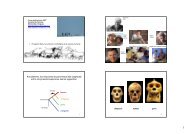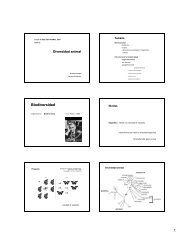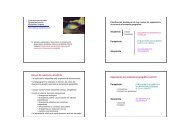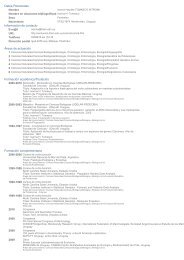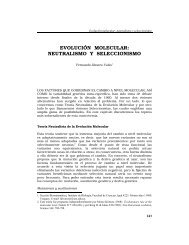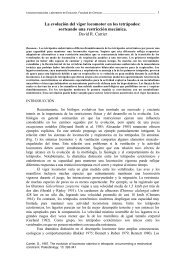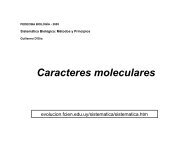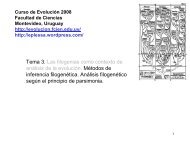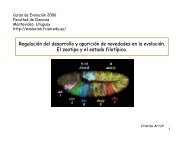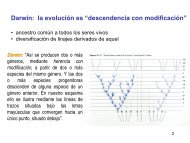C - Facultad de Ciencias
C - Facultad de Ciencias
C - Facultad de Ciencias
Create successful ePaper yourself
Turn your PDF publications into a flip-book with our unique Google optimized e-Paper software.
Curso: Principios y métodos <strong>de</strong> la<br />
Sistemática Cladística.<br />
Clase 4. Búsquedas y pesado <strong>de</strong><br />
caracteres<br />
Fernando Pérez-Miles<br />
Entomología,<br />
<strong>Facultad</strong> <strong>de</strong> <strong>Ciencias</strong>
Búsqueda: es el proceso para<br />
encontrar el árbol que mejor se<br />
ajuste a las observaciones<br />
• Tedioso/presenta dificulta<strong>de</strong>s.<br />
• No hay una fórmula.<br />
• Mucho consumo <strong>de</strong> tiempo-computacional.<br />
• Depen<strong>de</strong> <strong>de</strong>l Nº <strong>de</strong> taxones.
Para buscar todos los árboles<br />
posibles para 20 taxa<br />
• Con una computadora que revise 1.000.000<br />
<strong>de</strong> árboles por segundo (no existe por ahora<br />
tal computadora)<br />
• Se necesitan 260 millones <strong>de</strong><br />
años!!!
Número <strong>de</strong> árboles dicotómicos<br />
posibles para 3-20 taxones<br />
Taxa<br />
Nº <strong>de</strong> árboles<br />
Taxa<br />
Nº <strong>de</strong> árboles<br />
3<br />
3<br />
12<br />
13.749.310.575<br />
4<br />
15<br />
13<br />
316.234.143.225<br />
5<br />
105<br />
14<br />
7.905.853.580.625<br />
6<br />
945<br />
15<br />
213.458.046.676.875<br />
7<br />
10.395<br />
16<br />
6.190.283.353.<br />
8<br />
135.135<br />
17<br />
191.898.783.962.510.625<br />
9<br />
2.027.025<br />
18<br />
6.332.659.870.762.850.625<br />
10<br />
34.459.425<br />
19<br />
221.643.095.476.699.771.875<br />
11<br />
654.729.075<br />
20<br />
8.200.794.532.637.891.559.375
Para t taxa el número <strong>de</strong> árboles y<br />
networks posibles es<br />
(2 t – 3)!! árboles<br />
(2 t – 5) !! networks
Con los programas actuales<br />
• Para 20 taxa se encuentran soluciones<br />
garantizadas entre 1 minuto y pocas horas<br />
• Para 50-100 taxa entre 1-2 minutos y<br />
pocos días.
Soluciones exactas<br />
• Implicit enumeration Hennig 86<br />
• Branch & Bound Nona<br />
• 15-20 taxones 1 minuto a varios días<br />
• 25 taxones varios días<br />
• 25 o más taxones impracticable por el<br />
tiempo que insumen
Árbol <strong>de</strong> Wagner (ensayo y error)<br />
• Secuencias <strong>de</strong> adición or<strong>de</strong>nadas<br />
X<br />
A<br />
B<br />
0<br />
1<br />
1<br />
0<br />
0<br />
0<br />
0<br />
0<br />
0<br />
0<br />
0<br />
1<br />
0<br />
0<br />
1<br />
X<br />
C<br />
D<br />
B<br />
A<br />
C<br />
D<br />
0<br />
0<br />
1<br />
1<br />
1<br />
1<br />
1<br />
0<br />
1<br />
0<br />
2<br />
3<br />
1<br />
Árbol<br />
correcto<br />
apomorfía<br />
paralelismo<br />
7 pasos
Árbol <strong>de</strong> Wagner (ensayo y error)<br />
X<br />
A<br />
B<br />
C<br />
D<br />
• Secuencias <strong>de</strong> adición or<strong>de</strong>nadas<br />
0 0 0 0 0<br />
1 0 0 0 0<br />
1 0 0 1 1<br />
0 1 1 1 1<br />
0 1 1 0 0<br />
reversión<br />
C<br />
B 1 A<br />
X<br />
2<br />
3<br />
4<br />
5<br />
1<br />
6 pasos<br />
Sin D +2
Árbol <strong>de</strong> Wagner (ensayo y error)<br />
X<br />
A<br />
B<br />
C<br />
D<br />
• Secuencias <strong>de</strong> adición or<strong>de</strong>nadas<br />
0 0 0 0 0<br />
1 0 0 0 0<br />
1 0 0 1 1<br />
0 1 1 1 1<br />
0 1 1 0 0<br />
B C<br />
1<br />
2<br />
X<br />
3<br />
4<br />
5<br />
1<br />
A<br />
4<br />
5<br />
8 pasos<br />
Sin D +2
Árbol <strong>de</strong> Wagner (ensayo y error)<br />
• Secuencias <strong>de</strong> adición or<strong>de</strong>nadas<br />
X<br />
A<br />
B<br />
C<br />
D<br />
0<br />
1<br />
1<br />
0<br />
0<br />
0<br />
0<br />
0<br />
1<br />
1<br />
0<br />
0<br />
0<br />
1<br />
1<br />
0<br />
0<br />
1<br />
1<br />
0<br />
0<br />
0<br />
1<br />
1<br />
0<br />
X<br />
C<br />
B<br />
2<br />
3<br />
5<br />
1<br />
4 5<br />
A<br />
4<br />
7 pasos<br />
Sin D + 2
El árbol <strong>de</strong> Wagner<br />
• Tiene el problema <strong>de</strong> la secuencia <strong>de</strong><br />
adiciones<br />
• Es complicado para problemas <strong>de</strong> más <strong>de</strong><br />
15-20 taxa.<br />
• Son rápidos y buenos puntos <strong>de</strong> partida para<br />
el análisis<br />
• Dan árboles más cortos que lo realizados al<br />
azar.
Soluciones Heurísticas<br />
• Permutación <strong>de</strong> Ramas (Branch Swapping)<br />
- SPR (corte simple y reconección)<br />
- TBR (corte con reenraizamiento)
A<br />
D<br />
SPR<br />
B<br />
C<br />
E<br />
F<br />
D<br />
A<br />
B<br />
C<br />
E<br />
F
D<br />
SPR<br />
E<br />
C<br />
A<br />
F<br />
D<br />
E<br />
B<br />
A<br />
B<br />
C<br />
F
A<br />
TBR<br />
D<br />
B<br />
E<br />
C<br />
F<br />
A<br />
B<br />
E<br />
F<br />
C<br />
D
TBR<br />
A<br />
B<br />
E<br />
F<br />
C<br />
D<br />
A<br />
C<br />
B<br />
E<br />
D<br />
F
2<br />
SPR genera 3 T posibilida<strong>de</strong>s<br />
3<br />
TBR genera T /2 posibilida<strong>de</strong>s
Problema <strong>de</strong> “Islas”<br />
A B C D E F G H I J<br />
J<br />
B C D E F G H I<br />
A
Problema <strong>de</strong> “Islas”<br />
Parsimonia<br />
Óptimos locales
Soluciones al problema <strong>de</strong> “islas”<br />
• Guardar subóptimos (mucho tiempo <strong>de</strong><br />
corrida, poco efectivo)<br />
• Múltiples secuencias <strong>de</strong> adición (partir <strong>de</strong><br />
varios Wagner, EFECTIVO)<br />
• Doble SPR o Doble TBR (corto en 2<br />
puntos, poco efectivo)
Índice <strong>de</strong> Consistencia<br />
Para 1 carácter c = m/s<br />
m es el mínimo cambio <strong>de</strong> un carácter<br />
s es el número <strong>de</strong> pasos efectivos <strong>de</strong>l<br />
carácter<br />
Para el árbol<br />
C = M/S M =Σm y S =Σs
Índice <strong>de</strong> Consistencia<br />
X<br />
A<br />
B<br />
1 2<br />
0 0<br />
1 0<br />
1 1<br />
3<br />
0<br />
0<br />
1<br />
4<br />
0<br />
1<br />
0<br />
A B C<br />
4<br />
4<br />
2 3<br />
1<br />
c = m/s<br />
C<br />
1<br />
1<br />
1<br />
1<br />
c1 = 1/1 = 1<br />
c4= 1/2 = 0.5<br />
Para el árbol CI = 4/5 = 0.80
El índice <strong>de</strong> consistencia<br />
• Aumenta con las autapomorfías<br />
• Aumenta en matrices chicas<br />
• No varía con T<br />
• Su variación va <strong>de</strong> 0 a 1 (nunca llega a 0).<br />
• El índice <strong>de</strong> homoplasia (H) es<br />
H = 1 – C 1-M/S S-M/S
g es el mayor número <strong>de</strong> pasos <strong>de</strong> un<br />
carácter en un cladograma irresuelto (en<br />
binarios = al número <strong>de</strong> apomorfías<br />
Para los multiestados: estado más frecuente y<br />
un paso por cada otro estado.<br />
0 0<br />
0<br />
11 1<br />
1<br />
0 0 1 0 1 1<br />
g = 3<br />
m = 1
Indice <strong>de</strong> retención<br />
r = g – s/ g – m<br />
• Información retenida como<br />
sinapomorfías<br />
• No es influenciado por las autapomorfías<br />
• Varía entre 0 y 1<br />
• Cuando m = g = s<br />
el carácter no es informativo
Indice <strong>de</strong> consistencia reescalado<br />
Rc = R x C<br />
El Rc si pue<strong>de</strong> llegar a 0
PESADO DE CARACTERES<br />
OJO!!!!!<br />
NO SE TRATA DE PESOS A PRIORI
Si no existiera conflicto entre<br />
caracteres el pesado sería<br />
innecesario<br />
X<br />
A<br />
0<br />
1<br />
0<br />
0<br />
0<br />
0<br />
A B C<br />
B<br />
1<br />
1<br />
1<br />
C<br />
1<br />
1<br />
1
Pero...usualmente hay conflicto,<br />
hay homoplasia...<br />
X<br />
A<br />
B<br />
C<br />
1 2<br />
0 0<br />
1 0<br />
1 1<br />
1 1<br />
3<br />
0<br />
0<br />
1<br />
1<br />
4<br />
0<br />
1<br />
0<br />
1<br />
A B C<br />
4 4<br />
3<br />
2<br />
1<br />
A B 4 C<br />
Ambos<br />
L=5<br />
1<br />
4<br />
2<br />
3
El árbol que produce el carácter 4<br />
<strong>de</strong>ja en conflicto 2 caracteres, es<br />
menos parsimonioso se <strong>de</strong>scarta<br />
X<br />
A<br />
B<br />
C<br />
1 2<br />
0 0<br />
1 0<br />
1 1<br />
1 1<br />
3<br />
0<br />
0<br />
1<br />
1<br />
4<br />
0<br />
1<br />
0<br />
1<br />
B A C<br />
2<br />
3<br />
4<br />
1<br />
L = 6
Pesar los caracteres significa:<br />
• Medir su ajuste a un árbol dado<br />
• Calcular ¿cuán confiable es la evi<strong>de</strong>ncia<br />
(carácter)?<br />
• Tendrán mayor peso los caracteres más<br />
consistentes<br />
• Se reducirá el peso <strong>de</strong> los más homoplásicos
Pesajes sucesivos (Farris 1969)<br />
proceso iterativo<br />
PESOS INICIALES (IGUALES)<br />
CLADOGRAMA<br />
MEDIR HOMOPLASIA<br />
Se repite el<br />
proceso hasta<br />
que los pesos<br />
no cambien<br />
PESOS<br />
w = ri x ci x 10
Pesos implícitos (Goloboff 1993)<br />
• El peso (ajuste) es tomado como una<br />
función cóncava <strong>de</strong> la homoplasia.<br />
f = K/K+Es<br />
Es = pasos extra <strong>de</strong>l carácter (extra steps).<br />
K = constante <strong>de</strong> concavidad (1 a 6?)
W<br />
Ajuste<br />
Pasos, homoplasia<br />
W<br />
Ajuste<br />
Pasos, homoplasia
Consecuencias sobre la elección<br />
<strong>de</strong> árboles (parsimonia)<br />
Carácter<br />
1<br />
Carácter<br />
2<br />
Largo<br />
total<br />
Arbol 1<br />
1<br />
24<br />
25<br />
Arbol 2<br />
2<br />
23<br />
25
Una menos...



